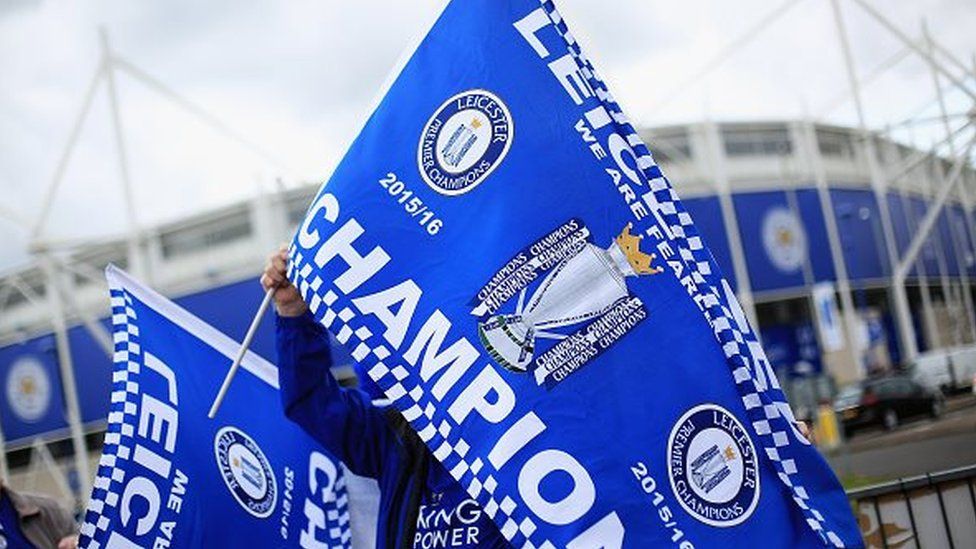City of champions: How well do you know Leicester?
- Published

Leicester City may have won the Premier League title in one of the greatest sporting achievements of all time, but how well do you know the home of the Foxes?
From the birth of package holidays to Walkers crisps and even the discovery of a celebrated king - there's more to the city of Leicester than just a Champions League football team.
Here are nine colourful facts about the East Midlands city:
Richard III
In 2013 the skeleton of English king Richard III was found beneath a Leicester car park.
King Richard was killed in battle at Bosworth in 1485 after only two years on the throne.
Experts from the University of Leicester said DNA from the bones matched that of descendants of the monarch's family.
In March 2015 a service to mark the king's reburial took place at Leicester Cathedral.
Walkers crisps
Henry Walker first started making his potato-based snacks in Leicester in 1948.
To mark Leicester City winning the Premier League, Walkers now plans to produce limited bags of salt and vinegar crisps called "salt and victory".
Celebrated former Leicester and England footballer Gary Lineker has long been associated with the brand, appearing in adverts for the crisps.
Walkers also started a "Countdown to Kit Off" digital striptease, following Lineker's promise to present Match of the Day wearing only his underpants if Leicester City were crowned champions.
The countdown saw images of Lineker on Twitter covered in crisp packets, which were gradually removed as the Foxes moved closer to the title.
Attenborough Arts Centre
Leicester is home to the Attenborough Arts Centre.
The £1.5m gallery extension was opened in January by Sir David Attenborough, after it was championed by his late brother, the actor Richard Attenborough.
The brothers grew up in Leicester after their father, Fredrick, was appointed Principal of the city's University College.
The family lived in College House, which is now part of the Department of Mathematics at the University of Leicester.
Sir David told the BBC that growing up in Leicester provided him with a "rich cultural upbringing".
He said he "owes a lot to Leicester and the people of Leicester".
Sir David Attenborough spoke about life in Leicester
DNA fingerprinting
In 1984, Sir Alec Jeffreys discovered the technique of genetic fingerprinting in a laboratory in the University of Leicester's department of genetics.
He told of his "eureka moment" in an interview for the university's website.
"My life changed on Monday morning at 9.05am, 10 September 1984," he said. "What emerged was the world's first genetic fingerprint."
Thomas Cook
On 9 June 1841 a 32-year old cabinet maker named Thomas Cook walked from his home in Market Harborough to the nearby town of Leicester where he began his international travel company in 1841.
Thomas Cook grew from these humble beginnings to become the high street travel agent we know today, arranging journeys around the globe.
Leicester Market
Leicester is home to one of the largest and oldest outdoor, covered markets of its kind anywhere in Europe.
Stalls offer fresh fruit and vegetables, seafood, meat, cheese and hardware.
More than 270 stalls are available every day, between 07:00 and and 18:00 BST.
Gary Lineker's father, Barry, also worked as a fruit and vegetable trader at Leicester Market.
Diwali
Leicester hosts what is thought to be one of the largest Diwali parties outside India. The annual celebration is held in Belgrave Road - more commonly known as the Golden Mile.
In 2015 more than 37,000 people attended a lights switch-on event in the heart of the city's Asian community.
The party culminates in a large firework display.
National Space Centre
In 2001, Leicester became home to the National Space Centre, which is devoted to education, entertainment and space exploration.
Over the last decade the interactive visitor attraction has welcomed nearly 2.5m people through its doors, including 600,000 school children, a host of former astronauts and members of the Royal Family.
The idea for the centre came about in the mid 1990s as a joint project between the city council and the University of Leicester, after university staff thought a visitor attraction based around space might attract more students to its Space Research Centre.
The centre's 42m (137 ft) high tower is the only known building in the world to house upright rockets indoors.
Local Radio
BBC Radio Leicester became Britain's first mainland local radio station when it launched on 8 November 1967.
At first, Radio Leicester made under four hours of local programmes each day. Leicester City and Leicester Tigers featured on the station, but its first major challenge was covering the huge floods that hit the city in 1968.
Despite limited resources, the station managed live reports from rowing boats floating down suburban streets.
Two years later, the local radio experiment was declared a success and BBC Radio Leicester expanded, paving the way for many more local stations across the country.
- Published2 May 2016
- Published30 June 2011
- Published1 October 2013
- Published5 August 2014
- Published3 November 2013
- Published4 February 2013